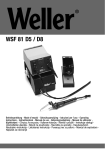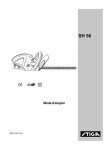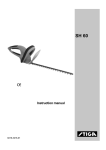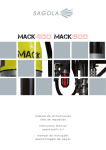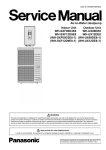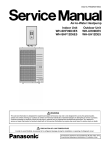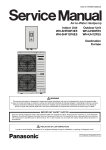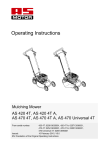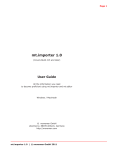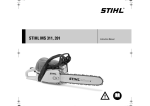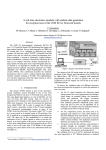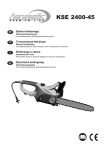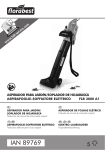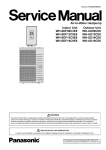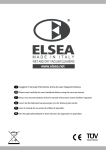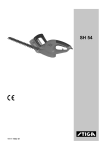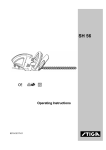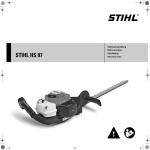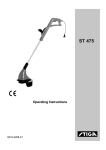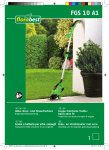Download User manual
Transcript
KSE DE GB FR NL IT ES PT NO DK SE FI Gebrauchsanweisung Vor Inbetriebnahme Gebrauchsanweisung lesen ! Operating Instructions Read operating instructions before use! Manuel d’utilisation Lire attentivement le mode d'emploi avant chaquemise en service ! Gebruiksaanwijzing Voor inwerkingstelling de gebruiksaanwijzing lezen! Istruzioni per l’uso Prima della messa in funzione leggere le istruzioni perl'utilizzo! Instrucciones de Manejo ¡Lea las instrucciones de manejo antes de efectuar la puerta en marcha! Instruções de Serviço Antes da colocação em funcionamento leia o manual de instruções! Bruksanvisning Les bruksanvisningen før bruk! Brugsanvisning Læs instruktionerne, inden maskinen tages i brug! Bruksanvisning Läs bruksanvisningen före användning! Käyttöohjeet Lue käyttöohjeet ennen käyttöä! 1 2 15 9 1 3 4 16 B 8 A 3 mm 7 5 6 2 2 4 7 8 17 9 3 12 11 3 15 4 2 9 14 5 10 16 8 6 7 13 1 2 3 4 5 6 7 8 9 10 11 12 13 14 15 16 DE Ölsichtfenster (siehe Abb. 2) Vorderer Handgriff Öltankverschluß Vorderer Handschutz Schwert Sägekette Knebelschraube Ritzeldeckel Schalter Hinterer Handschutz Hinterer Handgriff Netzleitung mit Stecker Schwertschutz Fällgriff Sperrknopf (siehe Abb. 2) Rändelrad zur Kettenschnellspannung NL 1 Oliekijkglas (zie afb. 2) 2 3 4 5 6 7 8 9 10 11 12 13 14 15 16 Voorste handgreep Olietankdop Voorste handbeschermer Zwaard Zaagketting Vleugelschroef Afdekkap Schakelaar Achterste handbeschermer Achterste handgreep Netsnoer met stekker Zwaardbeschermer Velgreep Veiligheidsknop (zie afb. 2) Kartelwiel voor het snel spannen van de ketting 1 2 3 4 5 6 7 8 9 10 11 12 13 14 15 16 1 2 3 4 5 6 7 8 9 10 11 12 13 14 15 16 GB Oil inspection window (see Fig. 2) Front handle Oil tank cap Front hand protection Blade Saw chain T-screw Pinion lid Switch Rear hand protection Rear handle Mains connection with plug Blade protection Fell handle Stopping button (see Fig. 2) Knurling wheel for quick chain tension adjustment IT Finestrella di controllo dell'olio (vedi ill. 2) Impugnatura anteriore Tappo del serbatoio dell'olio Protezione anteriore delle mani Spada Catena di taglio Vite ad aletta Coperchio zigrinato Interruttore Protezione posteriore delle mani Impugnatura posteriore Cavo d'alimentazione con spina Protezione della spada Impugnatura d'abbattimento Pulsante di bloccaggio (vedi ill. 2) Rotella zigrinata per bloccaggio rapido della catena 4 1 2 3 4 5 6 7 8 9 10 11 12 13 14 15 16 FR Ecran témoin pour niveau d'huile (voir ill. 2) Poignée avant Couvercle du réservoir d'huile Protège-main avant Guide Chaîne de la scie Vis à garret Couvercle à pignon Interrupteur Protège-main arrière Poignée arrière Câble avec fiche Protège-guide Poignée d'abattage Bouton d'arrêt (voir ill.2) Roue à molette pour une tension rapide de la chaîne E 1 Ventanilla de control de aceite (véase la Fig. 2) 2 Empuñadura delantera 3 Cierre del depósito de aceite 4 Guardamanos delantero 5 Cuchillas-espada 6 Cadena de sierra 7 Tornillo de muletilla 8 Tapa de piñón 9 Interruptor 10 Guardamanos posterior 11 Empuñadura posterior 12 Cable de red con conector 13 Protección de cuchillas-espada 14 Mango de leñador 15 Botón de bloqueo (véase la Fig. 2) 16 Rueda moleteada para tensar rápidamente la cadena 1 2 3 4 5 6 7 8 9 10 11 12 13 14 15 16 1. 2. 3. 4. 5. 6. 7. 8. 9. 10. 11. 12. 13. 14. 15. 16. PT Visor do óleo (ver Fig. 2) Manípulo dianteiro Tampa do tanque de óleo Protecção dianteira da mão Lâmina Corrente da serra Parafuso com pega Tampa do pinhão Interruptor Protecção traseira da mão Manípulo traseiro Cabo de rede com ficha Protecção da lâmina Cabo de lenhar Botão de bloqueio (ver Fig. 2) Roda serrilhada para tensão rápida da corrente 1. 2. 3. 4. 5. 6. 7. 8. 9. 10. 11. 12. 13. 14. 15. 16. SE Oljekontrollfönster ( se bild 2 ) Främre handgrepp Oljetankslock Främre handskydd Svärd Sågkätting Vingskruv Kugghjulslock Strömbrytare Bakre handskydd Bakre handgrrepp Nätanslutningskabel med stickkontakt Svärdskydd Fällgrepp Spärrknapp ( se bild 2 ) Räfflad ratt för snabbspänning av kedjan NO Oljeseglass (se fig. 2) Fremre håndtak Oljetanklokk Fremre håndvern Sverd Kjede Vingeskrue Tannhjulsdeksel Bryter Bakre håndvern Bakre håndtak Nettkabel med støpsel Sverdbeskyttelse Fellingshåndtak Sperreknapp (se fig. 2) Serratert hjul for hurtigstramming av kjede 1. 2. 3. 4. 5. 6. 7. 8. 9. 10. 11. 12. 13. 14. 15. 16. 2 3 DK Olievindue (se ill. 2) Forreste håndtag Låg til olietank Forreste håndbeskyttelse Sværd Savkæde Tersskrue Låg til tandhjul Kontakt Bagerste håndbeskyttelse Bagerste håndtag Netkabel med stik Sværdbeskyttelse Fældehåndtag Spærrekontakt (se ill. 2) Fingerhjul til hurtigstramning af kæde FI Öljynnäyttöikkuna (katso kuvaa 2) Etumainen käsikahva Öljysäiliön kansi Etumainen käsisuoja Miekka Sahaketju Sakararuuvi Uritettu kansi Kytkin Takimmainen käsisuoja Timmainen käsikahva Verkkojohto pistokkeella Miekkasuoja Kaatamiskahva Sulkunuppi (katso kuvaa 2) Pyällyskiekko ketjun pikakiristystä varten Abbildung und Erklärung der Piktogramme Représentation et explication des pictogrammes Illustrazione e spiegazione dei simboli Imagens e Explicações dos Pictogramas Piktogramillustration og forklaring Symbolien selitykset 1 1. 2. 3. 4. 5. 6. 7. 8. 9. 10. 11. 12. 13. 14. 15. 16. Illustration and explanation of pictograms Afbeelding en toelichting van de pictogrammen Símbolos y su significado Illustrasjon og forklaring av symboler Illustration och förklaring av symboler 4 5 6 7 1 3 5 7 DE Augen- / Kopf- und Gehörschutz tragen! Vor Gebrauch Gebrauchsanweisung lesen Bei Beschädigung der Anschlußleitung sofort Netzstecker ziehen Mit beiden Händen halten! 2 Warnung! 4 Dieses Werkzeug nicht dem Regen aussetzen 6 Achtung, Rückschlag! 1 3 5 7 GB Wear eye, head and ear protection ! Read operation instructions before use Remove plug immediately if the power flex is damaged or cut Hold tool with both hands! 2 Warning! 4 Do not subject this electric power tool to rain 6 Attention, kick-back! FR 1 Toujours protéger les yeux, la tête et les oreilles! 2 Attention! 3 Lire le manuel d’utilisation avant de se servir de la machine 4 Ne pas laisser cet outil électrique sous la pluie! 5 En cas de détérioration ou section du câble retirer immédiatement la prise 6 Attention aux rebondsl! NL 1 Oog- / hoofd- en gehoorbescherming dragen! 3 Voor inbedrijfstelling gebruiksaanwijzing lezen 5 Bij beschadiging of doorsnijden van de aansluitingsleiding dadelijk de stekker uittrekken 7 Werktuig met 2 handen houden IT 1 Indossare occhiali protettivi, copricapo e paraorecchi! 3 Leggere le istruzioni sull’uso prima della messa en marcia 5 In caso di danneggiamento o taglio della linea di allacciamento, tirare immediatamente la spina. 7 Tenere con tutte e due le mani!! ES 1 Llevar protección para los ojos, la cabeza y el oído. 3 Lea las instrucciones de manejo antes de usar la máquina 5 Al dañarse o cortarse el cable de red desenchufe inmediatamente el aparato 7 Solamente manejar con las dos manos PT 1 Trajar protecção para os olhos, cabeça e ouvidos! 3 Antes de utilizar, ler as instruções de servicio 5 Em caso de danificar ou cortar o cabo eléctrico, tire a fiche de rede imediatamente! 7 Só manejar com ambas as mãos! 1 3 5 7 2 Avvertimento! 4 Non esporre questo utensile alla pioggia 6 Attenzione: Ritorno! 2 Cuidado! 4 No exponga esta herramienta a la lluvia 6 Atención: Rebote! 2 4 6 NO Bruk øye-, hode- og hørselsvern! Les bruksanvisningen før bruk! Trekk øyeblikkelig støpselet ut hvis ledningener skadet! Hold fast med begge hender! Atenção! Não expor esta ferramenta eléctrica à chuva Atenção: Recuo!! 2 Advarsel! 4 Ikke bruk dette elektriske redskapet i fuktig vær! 6 Obs! Tilbakeslag! DK 1 Anvend øjen- / hoved- og høreværn! 3 Læs instruktionerne, inden maskinen tages i brug! 5 Tag stikket ud, hvis ledningen bliver beskadiget eller klippet over! 7 Hold saven med begge hænder 1 3 5 7 2 Waarschuwing! 4 Dit elektrowerktuig niet de regen onderwerpen! 6 Attentie, terugslaggevaar! 2 Advarsel! 4 Brug ikke dette elektriske apparat i fugtigt vejr! 6 Advarsel: Tilbage kast. SE Använd ögon- / huvud- och hörselskydd! Läs bruksanvisningen före användning! Ta genast bort kontakten om sladden skadas eller går av! Håll med båda händerna! FI 1 Käytä silmien- / pään- ja kuulonsuojaimia! 3 Lue käyttöohjeet ennen käyttöä! 5 Irrota pistoke välittömästi, jos verkkojohto on vauriotunut tai katkennut! 7 Pidä kiinni molemmin käsin! 2 Varning! 4 Använd inte detta eldrivna redskap i fuktig väderlek! 6 Varning för kast! 2 Varoitus! 4 Älä käytä tätä sähkökäyttösistä työvälinettä märällä ilmalla! 6 Huomio! Takaiskun vaara! 10/2003 6 ENGLISH Introduction to the Operating Instructions These Operating Instructions are intended to facilitate your becoming acquainted with the machine and using it in accordance with the regulations. The Operating Instructions contain important information on how to use the machine safely, correctly and economically. Observing this information will help increase the reliability and working life of the machine. The Operating Instructions must always be at hand when the machine is being used. They must be read and observed by every person dealing with the machine, whether operating, servicing or transporting it. In addition to the Operating Instructions and the applicable rules of the prevention of accidents valid in the country of use and on site, the generally recognised rules on working safely and correctly must be observed as well as the accident prevention rules of the relevant professional associations. Technical Data This chain saw has been built in accordance with Regulation DIN EN 50144-2-13 and fulfils the requirements of the European law on equipment safety. Model KSE 1800 2000 Rated Voltage V~ 230 230 Nominal Frequency Hz 50 50 50Fuse (time lag) A 16 16 Rated Output W 1800 2000 Nominal current A 8,4 9,4 Guide Bar cm 30-45 30-45 Speed m/sec ca. 11 ca. 11 Weight kg ca. 4,3 ca. 4,4 Oil ml 200 200 All models with automatic chain lubrication and mechanical chain brake and rundown brake. The type designation of the chain you will find on the type plate. Class of Protection: II/ DIN-EN 50144/ VDE 0740 Interference Suppression: nach EN-55014 Information on noise emission in accordance with the 3rd Decree on the German law on equipment safety of 18.1.1991 and the EU Guideline on machines, Appendix I, Section 1.7.4 f. Noise emission values EN-50144-2-13: Vibration values in accordance with EN 50144-2-13: Sound Pressure Level LpA Weighted acceleration handle 93 dB (A) max. 5,5 m/s2 Attention: This chain saw is only intended for cutting wood !!! Important instructions for your personal safety A) General safety instructions Attention: You run danger of injuring yourself if you use the chain saw incorrectly. It is imperative that you read these Operating Instructions and follow the instructions given. Attention: Noise protection ! Please observe the local regulations when operating your device. 1. Caution! : When electric tools are being used, the following basic safety measures must be taken to protect against electric shock, injury and risk of fire. 2. Protect yourself against electric shock. Avoid body contact with grounded elements, e.g. pipes, radiators, stoves, refrigerators. 3. Children and young persons under 18 may not operate electrical chain saws, with the exception of apprentices older than 16 under the supervision of a trained adult. 4. The chain saw may only be used by persons who have sufficient experience. 5. Always keep these Operating Instructions together with the chain saw. 6. Only lend or give this chain saw to persons who are familiar with its use. Also give them these Operating Instructions. 7. You should always be in a good physical state when working with the chain saw. Work steadily and with concentration. Particular concentration is necessary towards the end of your duty. 8. Never use the chain saw while under the influence of alcohol, medication or drugs. B) Instructions on the use of personal protective clothing Working with a chain saw requires special measures with regard to protective equipment and clothing suitable for protecting your head, hands, feet and legs, eyes and ears. 9. Wear close fitting clothing which cannot get caught 10. Always wear an approved and tested safety helmet when felling trees and removing branches. 11. Always wear safety goggles or a face guard. 12. Always wear suitable protective gloves. 13. Wear ear protection to avoid damage to your hearing. 14. Wear safety boots. 15. We recommend that you wear leg guards. GB-1 C) Instructions on using the chain saw safely 16. Attention! Read the Operating Instructions carefully and have yourself instructed in the use of a chain saw before you use it for the first time. 17. Always store your electric tools in a safe place. Electric tools not being used should be stored in a dry, inaccessible or locked place, outside the reach of children. 18. Use the cable only for the intended purpose. Never carry or suspend electric devices by the cable. Do not use the cable to pull the plug from the socket. Protect the cable from heat, oil and sharp edges. 19. Check the extension cable regularly and replace it if it gets worn or damaged. Keep the handle dry and free of oil and grease. 20. Pull the plug from the socket when replacing the saw chain or sword. 21. Do not leave the tool key in the ignition. Check before switching on that the key and adjustment tools are removed. 22. Avoid accidental starting. Do not hold your finger on the switch when carrying an electric tool that is connected to the power source. Ensure that the switch is off when the plug is inserted in the socket. 23. Damaged switches have to be replaced by a customer service workshop. Do not use an electric tool if the switch cannot be switched on or off. 24. Caution: Only use accessories or parts that are listed in the operating instructions. Use of other tools and other accessories mean safety risks for the operator. 25. Never subjekt the electrical chain saw to rain and do not work in wet surroundings. 26. Check the chain saw for its proper operating state before every use.Please pay special attention to the sword and chain. 27. Check the power cable for damage or cracks every time before you use it. Damaged cables must be replaced. 28. Always hold the chain saw with both hands while working with it. 29. No other person may be within the working range of the chain saw. 30. The chain saw must be disconnected from the power supply before you tighten the chain, exchange the chain or carry out any other work on the saw. Withdraw the plug! 31. During work breaks put the machine down in such a manner that nobody is at risk. 32. Always use the chain cover when transporting the chain saw. 33. When switching on the chain saw, ensure that it is supported well and hold it firmly. The chain and bar must be free. 34. Before you start working ensure that you are standing firmly. 35. Withdraw the plug immediately if the power cable is damaged or cut. 36. Never cut with the tip of the bar - the saw may recoil (“kick-back”). 37. Do not use the chain saw near combustible gases or dust - danger of explosion. 38. The chain saw may only be connected to socket outlets with earthing contact and tested electrical installations. We recommend the use of a residualcurrent-operated circuit-breaker. The fuse must have a value of 16 A and mustn’t be used by other consumers while working with the chain saw. 39. The cable must be winded off completely when you use a cable drum. 40. Ensure that the power cable has no kinks and is not damaged. 41. The chain saw may only be used in a completely assembled state. No protective devices may be missing. 42. Switch the chain saw off immediately if you notice any changes in the machine. 43. Always have a first-aid kit fulfilling DIN 13164 at hand in case of accidents. 44. If the chain saw comes into contact with earth, stones, nails or other foreign objects, withdraw the plug immediately and check the chain as well as the bar. 45. Ensure that no chain oil penetrates into the earth or sewage. Always place the chain saw on something that will absorb any oil dripping from the bar or chain. D) Warning to the danger of recoil (“kickback”) 46. Attention: If the tip of the bar contacts a hard object while the motor is running, the saw may recoil dangerously. In recoiling, the chain saw is flung upwards at high speed towards the person holding the chain saw. 47. Do not touch wood or branches with the bar tip. 48. If possible, use a stand. 49. Always keep an eye on the bar tip. 50. Only place a running saw on the object to be cut. Never start the machine while the chain rests on something. 51. So called piercing cuts with the bar tip may only be carried out by trained personnel. E) Instructions on safe working techniques 52. Before starting to work ensure that there is sufficient light. 53. Always maintain a normal body posture when operating the device. Always keep your balance. 54. Do not work with your body bent forwards. 55. Ensure that you are standing securely and do not work on snow, ice or newly-barked wood. Danger of slipping! 56. Working on ladders, scaffoldings or trees is forbidden. 57. Do not use chain saw above shoulder height. 58. Use the chain saw only to cut wood. It is absolutely forebidden to cut plastics or minerals (gas concrete). 59. Ensure that the wood cannot twist while it is being cut. 60. Never climb on a tree to cut wood. 61. Watch out for splintering wood. While you are sawing you may be injured by flying wood chips. 62. Do not use the chain saw to lever or move the wood. 63. Only cut with the lower section of the saw. The saw will be repulsed towards you if you try and cut with the upper section of the saw. 64. Ensure that the wood is free of stones, nails or other foreign objects. GB-2 Starting up 1. Filling the oil tank (Fig. 1) The chain saw must never be operated without sufficient oil on the chain as this could cause damage to the chain, blade or motor. No claims for guarantee can be accepted if damage occurs when the device is being operated without chain oil. Please use only biologically-based chainsaw oil, i.e. oil which is 100% biologically decompos-able. Biological chainsaw oil should be available every-where at your local specialist dealer. Do not use old oil. This will damage the chainsaw and will also lead to loss of the guarantee. • Before filling the oil tank, pull out the mains plug • Open the twist cap and place safely aside so that the sealing ring in the tank cap does not get lost. • Fill approx. 200 ml oil into the tank using a funnel and screw on the tank cap tightly once more. • The oil level can be seen in the inspection window (Fig. 2). If you plan not to use the machine for a longer period, you should remo ve the chain oil from the oil tank. • The oil tank should also be emptied before the chainsaw is transported or dispatched. • Check correct functioning of the chainsaw before commencing work. Switch on the saw with cutting fittings assembled and hold over a bright background at a safe distance (Be careful not to come in contact with the ground !). An track of oil will show you that the chain is sufficiently lubricated. • After use, lay the chainsaw horizontally on some absorbing surface. The oil spread on the blade, chain and drive may lead to some further dripping of oil. 2. Assembling the blade and chain (Fig. 3) CAUTION ! Risk of injury ! Always use safety gloves when assembling the chain ! For assembling the bar and chain with this chain saw no tools are required ! • Put the chain saw on a stable rest. • Loosen the T-screw 7 turning it clockwise. • Remove the gear cover 8. • Put the chain on the bar considering the running direction of the chain. The cutting teeth on the upper side of the bar must point in forward direction (see Fig. 4). • Put the free end of the chain over the chain driving wheel (B). • Place the bar such that the long hole in the bar is placed exactly on the guiding element in the bar seat. • Take care that the chain tensioning bolt (A) is seated exactly in the small opening in the bar (Fig. 3). It must be visible through the opening. If necessary, adjust the knurling wheel of the chain tensioning device (16) in both directions until the chain tensioning bolt is seated in the opening in the bar. • Check whether all chain links are seated exactly in the bar’s groove and the chain is lead around the chain driving wheel correctly. • Put the gear cover 8 back on and push it in place. • Moderately tighten the T-screw 7 by turning it clockwise. • Tension the chain. To do so turn the knurling wheel upwards (+ direction of arrow). The chain should be tensioned such that it can be lifted by about 3mm in the middle of the bar (Fig. 4). To decrease the chain tension turn the knurling wheel downwards (- direction of arrow). • Finally, tighten the T-screw 7 well by hand. The tension in the chain has a major effect on the service life of the cutting fittings, and must therefore be checked regularly. When the chain warms up to operating temperature it will expand and must be retightened. A new saw chain will have to be tightened more frequently until it has reached its full length. CAUTION: During the running-in period, the chain must be more frequently tightened. The chain must be immediately retightened if it shakes or leaves the grove ! To tension the chain slightly loosen the T-screw 7. Then turn the knurling wheel upwards (+ direction of arrow). Tension the chain such that it can be lifted by about 3mm in the middle of the bar, as shown in Fig. 4. 3. Connecting the chainsaw (Fig. 5) We recommend to operate the chain saw in connection with a residual current operated device with a maximum breaking current of 30mA. This device is designed to be operated on a mains supply with a system impedance Z max at the point of connection (house service connection) of max. 0.4 Ohm. The user must ensure that the device is only operated on an electricity supply system meeting these requirements. If required, system impedance data may be obtained from the local public utility. Use only extension cords that are approved for outdoor use and are not lighter than rubbersheathed cables of type H07 RN-F according to DIN/ VDE 0282 with a diameter of at least 1.5 sq. mm. They cords must be splash-proof. If the connection cable of this device should be damaged it must be replaced by a workshop named by the manufacturer only as this work requires the use of special tools. Mobile devices for outdoor use should be connected over a residual current operated device. This chainsaw is fitted with a strain-relief device to provide extra safety for the connection. First connect the device plug with the connection line. Then form the connection line into a tight loop and push this through the safety web on the lower side of the machine. Hang the loop into the hook as shown in Fig. 6. The plug connection is now secure against automatic release. 4. Switching on (Fig. 2) • Press with your thumbs the stopping button 15 on the left side of the rear handle and then the operating switch 9. • The stopping button 15 is used for unlocking the switchon mechanism and does not need to be pressed again after the device is switched on. • To switch off the device, release switch 9. GB-3 Caution: The chainsaw will run immediately at full speed and will continue running for a certain period after it is switched off. You must wait until the chain has come to a full stop before putting chainsaw down. Safety devices on your chain brake 1. Chain brake (Fig. 6) This chain saw is equipped with a mechanical brake for the chain. In the case of uncontrolled movements, when the tip of the sax blade gets in contact with wood or a solid object, the drive of the chain is immediately stopped by activation of the hand guard 4, the motor will not be stopped. This brake function is initiated by the back of your hand on the front handle 2 pushing the hand guard. The proper function of the saw chain brake shall be checked before each use of the saw. CAUTION: No buttons should be pressed when the chain brake is released (hand protection pulled back in the direction of the handle and locked). Always ensure before starting the chainsaw that the hand protection 4 is locked in the operating position. To do this, pull back the hand protection in the direction of the handle. 2. Rundown brake In accordance with the latest regulations, this chain saw is equipped with a mechanical rundown brake. This brake is connected to the chain brake and stops the running chain after the chain saw has been switched off. It is activated by releasing the ON/OFF switch. The rundown brake avoids injuries through the coasting of the chain. 3. Safety starting lock The starting delay that is effective for about 3 sec. after each switch-off of the chain saw provides for additional safety. Thus, for your own safety, there is a delay of 3 seconds before the device can be switched on again after each time it is switched off. Only after this phase, the saw may be operated again by pushing the locking button 15 and subsequently activating the operating switch 9, as described in the section ‘Switching on’. 4. Chain catch bolt (Fig. 7) This chainsaw is fitted with a chain catch bolt (17). If the chain breaks when the saw is in operation, the chain bolt will catch the loose chain end and thus prevent injury to the operator's hand. Instructions on working properly with the chain saw (Fig. 8+9) Removing branches (Fig. 8) • Ensure that you are standing firmly. • Cut a deep notch from below into the branch about 15 cm from the trunk. • Now cut the branch from above about 5 cm further outwards from the lower notch until the branch drops off. • In order to remove the rest, cut from below about 1/3 into the remaining branch close to the trunk. • Cut into the branch from above until the branch has been removed completely. • Do not remove free-hanging branches from below. Felling a tree (Fig. 9) • Ensure that no one is within the felling area, minimum distance: 2 tree lengths. • Ensure that no one can be hit by falling branches or the tree to be felled. • Ensure that you have a possible escape route. • Ensure that you are standing firmly. • Keep the working area free of objects. • Always stand at the side of the tree during felling. • First determine in which direction the tree is to be felled. The felling notch is cut on this side of the trunk. • First cut 1/3 of the trunk diameter horizontally into the tree at the intended felling notch. • Now cut the second part of the felling notch from above at an angle of 45° to the first cut. • Now make the felling cut exactly opposite to the felling notch. The felling cut must run horizontal and a bit higher than the felling notch. • Do not cut completely through the tree. Leave about 1/ 10 of the trunk diameter. • Put wedges into the felling cut to bring the tree to fall. Cutting a felling tree • First support the trunk so that the section to be cut off always hangs freely and does not lie on anything so that the bar cannot jam. • If the chain saw does become jammed, switch it off immediately and withdraw the plug. Use the wedges to free the bar. • Avoid letting the saw chain coming into contact with the earth. General instructions on working with a chainsaw • Ensure that children and other spectators keep a safe distance from the working area. • Apply little pressure to the machine when sawing wood. If the chain is keen, it will cut almost by itself through the wood. • If possible, always work with the chainsaw running at high speed. • Never try to continue sawing with a blunt chain. That causes the motor to overheat and the loss of your right to claim under guarantee. Always have a replacement chain at hand. • Allow the motor to cool off and make working breaks. • After use always place the chain saw horizontally to avoid oil dripping from the oil reservoir. • Always use the chain cover when transporting the chain saw. Maintenance and Servicing Always withdraw the plug when carrying out maintenance and servicing. • Always remove wood shavings and oil from your chain saw after use. Ensure in particular that the motor ventilation slits for cooling the motor in the housing of the chain saw is free (danger of overheating). • If the saw chain is particularly dirty, e.g. in case of gumming with resin, remove the chain and clean it. Place the chain for a few hours in a vessel containing IKRA chainsaw cleaner. There-after clean the chain with clear water. If the chain is not used again immediately, it must be treated with IKRA-service spray or a customary anti-corrosion-spray. • Only in case of use of biological oil: As some biological oils may tend to incrustation after a time, the oiling system should be rinsed thoroughly before storing the chain saw for a longer period. Therefore, please fillhalf of the oil reservoir (about 50 ml) with IKRA chainsaw GB-4 • • • • • • • cleaner and close it as usually. Then switch on the chainsaw - without bar and chain being mounted - and keep it running until the total rinsing liquid has evapurated through the oil opening of the chain saw. Before using the chain saw again, it is absolutely necessary to refill the oil reservoir. Do not store the saw outdoors or in damp and moist areas. Check all the chain saw parts, in particular the chain, bar and sprocket, of wear after every use. Ensure that the chain tension is correct. If the chain is too loose, it may come off during use and lead to injuries. The chain must be replaced immediately if it is damaged. The cutting teeth must be at least 4 mm long. Check the motor housing and power cable after every use for damage. If there is any sign of damage, have the chain saw checked by a specialised workshop or the works after-sales service. Check the oil level and lubrication of your chain saw after every use. Insufficient lubrication leads to damage to the chain, bar and motor. Check how keen the chain is every time before you use the chain saw. A blunt chain will cause overheating of the motor. Sharpening a saw chain requires experience and specialised knowledge. We therefore recommend to have sharpening carried out by a specialised workshop. In the case of technical problems • The machine does not start up: Check whether the current socket is live. Check whether the power cable is undamaged. If neither case applies, take the chain saw to a specialised workshop or the works after-sales service. • Chain does not run: Check position of handguard (see ill. 7). Chain only runs if handguard brake is released. • Sparks fly at the motor: Motor or carbon brushes damaged. Take the chain saw to a specialised workshop or the works after-sales service. • Oil does not flow: Check the oil level. Clean the oil flow openings in the bar (see also the corresponding hints of “Maintenance and servicing). If this is not successful, take the chain saw to a specialised workshop or the works after-sales service. Attention: Any maintenance or repair work going beyond that described in these Operating Instructions may only be carried out by authorised persons or the works after-sales service. Attention: If the power supply lead of this device shows any defects, the lead must be replaced by an authorized repair shop only or through the manufacturer’s own service personnel, as this work requires special tools. Repair Service Repairs to electric power tools should only be carried out by specialist electrical personnnel. GB-5 11/2002 DE EG-Konformitätserklärung entsprechend der EG-Maschinenrichtlinie 98/37/EG Wir, ikra® GmbH, Schlesier Straße 36, D-64839 Münster / Altheim, erklären in alleiniger Verantwortung, dass das Produkt Kettensäge KSE 1600 / 1800 / 2000, auf das sich diese Erklärung bezieht, den einschlägigen Sicherheitsund Gesundheits-anforderungen der EG-Richtlinie 89/336/EWG (EMV-Richtlinie), 73/23/EWG (Niederspannungsrichtlinie), 98/37/EG (EG-Maschinenrichtlinie) und 2000/14/EG (Geräuschrichtlinie) entspricht. Zur sachgerechten Umsetzung der in den EG-Richtlinien genannten Sicherheits- und Gesundheitsanforderungen wurden folgende Normen und/oder technische Spezifikation(en) herangezogen: EN 50144-1, EN 50144-2-13, EN 55014-1, EN 55014-2, EN 61000, EN 50366, Baumusterprüfbescheinigung 1014 MSR, VDE Offenbach gemessener Schalleistungspegel : garantierter Schalleistungspegel : 98,3 dB (A) 101 dB (A) * Prüfstelle: DPLF, D-34114 Kassel Konformitätsbewertungsverfahren nach Anhang VI / Richtlinie 2000/14/EG Münster, 11.12.2003 GB Gerhard Knorr, Technischer Leiter EC Declaration of Conformity according to EU Guideline of Machines 98/37/EG We, ikra® GmbH, Schlesier Straße 36, D-64839 Münster / Altheim, declare under our sole responsibility that the products KSE 1600 / 1800 / 2000, to which this declaration relates correspond to the relevant basic safety and health requirements of Directives 89/336/EEC (EMV-Guideline), 73/23/EEC (Low Voltage Guideline), 98/37/EG (EU Guideline of Machines ) and 2000/14/EC (noise directive). For the relevant implementation of the safety and health requirements mentioned in the Directives, the following standards and/or technical specification(s) have been respected: EN 50144-1, EN 50144-2-13, EN 55014-1, EN 55014-2, EN 61000, EN 50366, Engineering type licence No. 1014 MSR, VDE Offenbach measured acoustic capacity level : granted acoustic capacity level : 98,3 dB(A) 101 dB(A) * Testing laboratory: DPLF, D-34114 Kassel Conformity assessment method to annexe VI / Directive 2000/14/EC Münster, 11.12.2003 FR Gerhard Knorr, Technical Director Déclaration de Conformité pour la CE conforme à la directive CE sur les machines 98/37/EG Nous, ikra® G mbH, Schlesier Straße 36, D-64839 Münster / Altheim, déclarons sous notre seule responsabilité que les produits KSE 1600 / 1800 / 2000, faisant l’objet de la déclaration sont conformes aux prescriptions fondamentales en matière de sécurité et de santé stipulées dans les Directives de la CEE 98/37/EG (directive CE sur les machines), 89/336/CEE (directive EMV) , 73/23/CEE (directive de basse tension) et 2000/14/C.E. (directives en matière de bruit). Pour mettre en pratique dans les règles de l’art les prescriptions en matière de sécurité et de santé stipulées dans les Directives de la CEE, il a été tenu compte des normes et/ou des spécifications techniques suivantes: EN 50144-1, EN 50144-2-13, EN 55014-1, EN 55014-2, EN 61000, EN 50366, Attestation de type 1014 MSR, VDE Offenbach Niveau sonore mesuré : Niveau sonore garanti : 98,3 dB (A) 101 dB (A) * Service de contrôle : DPLF, D-34114 Kassel Procédure d’évaluation de conformité voir annexe VI / directive 2000/14/CE Münster, 11.12.2003 Gerhard Knorr, Directeur technique












